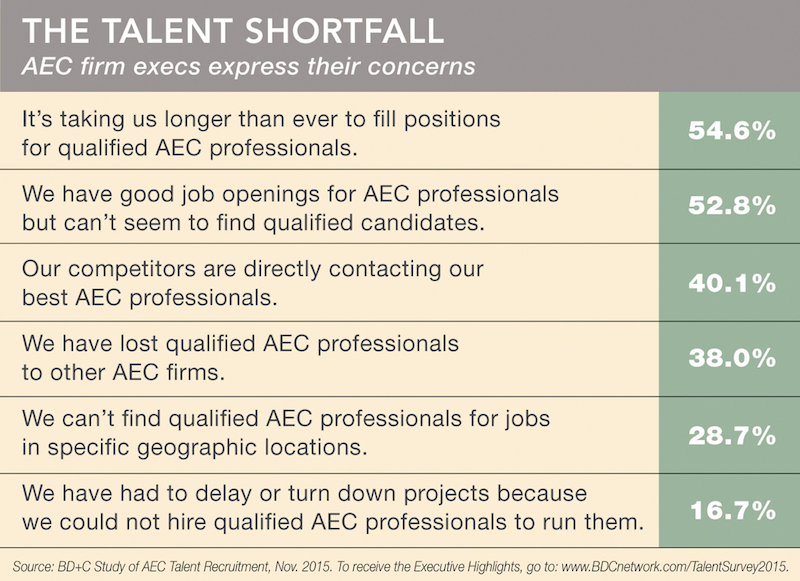U.S. architecture, engineering, and construction firms are being stymied by the shortage of experienced design and construction professionals and project managers, according to an exclusive Building Design+Construction survey of 133 C-suite executives and human resources directors at AEC firms.
“Finding good qualified people with experience in running projects is a challenge” is how one respondent summarized the AEC field’s shortage of so-called “seller-doers.”
Download a PDF of the survey findings (registration required)
Another industry executive worried about the AEC sector’s changing demographics, said: “There are not many young people entering the profession, and there is an extreme lack of talented people in the 10+ years’ level of experience,” said this respondent. “We have no problem hiring college graduates, but keeping them after five years is difficult, and then we start over with a new hire.”
KEY FINDINGS FROM THE SURVEY
- Four out of five respondents (81.7%) said they anticipate their firms will add at least 5% to their professional staffs over the next two years.
- “AEC professionals with 6–10 years’ experience” was cited by 24.2% of respondents as the staff category that is more than usually difficult to recruit or hire, followed by “AEC professionals with more than 10 years’ experience” (17.1%).
- Project managers were deemed the third most unusually difficult position to fill, at 16.3%.
- Bringing up the rear: “AEC professionals with 3–5 years’ experience,” at 13.3%.
 The majority of respondents said the hiring process for key professionals is taking longer than ever (54.6%). Less than one in five respondents (18.5%)
The majority of respondents said the hiring process for key professionals is taking longer than ever (54.6%). Less than one in five respondents (18.5%)
said their firms have not had serious problems hiring qualified professionals.
- “Specialty staff (IT, BIM/VDC, Revit, CAD, etc.)” were determined to be unusually difficult to recruit by 10.0% of respondents.
- Nearly six of 10 respondents (58.1%) said it has taken their firms four months or more to place their most difficult positions to fill.
- More than six in ten respondents (61.1%) said “flexible work hours” was offered as an incentive to attract qualified AEC professionals.
- Nearly seven in ten respondents (69.4%) stated that they used “word of mouth” (not specifically defined) as a recruiting tool. Nearly a quarter of respondents (23.2%) cited “word of mouth” as their firms’ most effective recruitment tool.
- The majority of respondents (54.6%) agreed with the statement, “It’s taking us longer than ever to fill positions for qualified AEC professionals.”
- More than four in five respondents (81.5%) reported one problem or other in their firms’ efforts to recruit and hire the right professionals.
Perhaps most startling of all was the finding that one in six respondents (16.7%) said their firms had delayed or turned down projects because they could not hire qualified AEC professionals to run them.
Respondents offered possible remedies for the talent shortfall. “Competition for talent is high,” said one respondent. “Focus by the entire team, including talent recruitment professionals, hiring managers, and company leadership, is key to success.”
“Firms need to realize that to attract and retain talent you cannot keep operating your company the same way they have been for the last few decades,” said another respondent. “You need to offer more vacation time, flexible hours, good insurance, a good salary. The firms that do this well do not seem to have issues with attraction and retention. Also, we have to be cognizant that these peak times will soon enough swing downward: they always do.”
Download a PDF of the survey findings (registration required).
Related Stories
Industry Research | Nov 8, 2016
Austin, Texas wins ‘Top City’ in the Emerging Trends in Real Estate outlook
Austin was followed on the list by Dallas/Fort Worth, Texas and Portland, Ore.
Industry Research | Nov 4, 2016
New survey exposes achievement gap between men and women designers
Female architects still feel disadvantaged when it comes to career advancement.
Market Data | Nov 2, 2016
Nonresidential construction spending down in September, but August data upwardly revised
The government revised the August nonresidential construction spending estimate from $686.6 billion to $696.6 billion.
Industry Research | Nov 1, 2016
Perkins Eastman Research releases white paper on ‘Centers for Healthy Living’ and whole-person wellness
Among the spotlight projects used as case studies for this white paper are C.C. Young, Dallas, Texas; Clark-Lindsey Village, Urbana, Ill.; Moorings Park, Naples, Fla.; NewBridge on the Charles, Dedham, Mass.; Rockwood Retirement Living: The Summit, Spokane, Wash.; Saint John’s on the Lake, Milwaukee, Wis.; and Spring Lake Village, Santa Rosa, Calif.
Market Data | Oct 31, 2016
Nonresidential fixed investment expands again during solid third quarter
The acceleration in real GDP growth was driven by a combination of factors, including an upturn in exports, a smaller decrease in state and local government spending and an upturn in federal government spending, says ABC Chief Economist Anirban Basu.
Market Data | Oct 28, 2016
U.S. construction solid and stable in Q3 of 2016; Presidential election seen as influence on industry for 2017
Rider Levett Bucknall’s Third Quarter 2016 USA Construction Cost Report puts the complete spectrum of construction sectors and markets in perspective as it assesses the current state of the industry.
Industry Research | Oct 25, 2016
New HOK/CoreNet Global report explores impact of coworking on corporate real rstate
“Although coworking space makes up less than one percent of the world’s office space, it represents an important workforce trend and highlights the strong desire of today’s employees to have workplace choices, community and flexibility,” says Kay Sargent, Director of WorkPlace at HOK.
Market Data | Oct 24, 2016
New construction starts in 2017 to increase 5% to $713 billion
Dodge Outlook Report predicts moderate growth for most project types – single family housing, commercial and institutional building, and public works, while multifamily housing levels off and electric utilities/gas plants decline.
Industry Research | Oct 20, 2016
New book from HDR explores opportunities for how healthcare organizations can reinvent the patient experience
Delta offers a close look at specific activities and behaviors that can help healthcare providers and caregivers discover revolutionary concepts to help them embrace and thrive in the rapid change that surrounds them.
Designers | Oct 12, 2016
Perkins Eastman and EwingCole co-publish new white paper examining the benefits and challenges of design research
The survey’s findings, combined with input from the EDRA conference, informed the content produced for “Where Are We Now?”

















